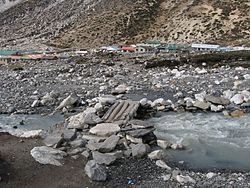Chukhung: Difference between revisions
Himalayan00 (talk | contribs) m Population of Chukhung |
Lodges Number in Chukhung village |
||
| Line 18: | Line 18: | ||
'''Chukhung''' is a lodge village serving [[trekking|trekkers]] and climbers in the [[Khumbu]] region of [[Nepal]] in the [[Himalaya]]s south of [[Mount Everest]].<ref>{{GEOnet2|32FA883812933774E0440003BA962ED3|Chukhung (Approved - N)}}, [[National Geospatial-Intelligence Agency|United States National Geospatial-Intelligence Agency]]</ref> As per 2011 census, this village has the population of 159 locals Sherpa's and 26 local households.<ref>{{cite web |last1=North |first1=Nepal Trek |title=Chukhung |url=https://northnepaltrek.com/everest-high-passes-trek |website=Chukhung}}</ref> |
'''Chukhung''' is a lodge village serving [[trekking|trekkers]] and climbers in the [[Khumbu]] region of [[Nepal]] in the [[Himalaya]]s south of [[Mount Everest]].<ref>{{GEOnet2|32FA883812933774E0440003BA962ED3|Chukhung (Approved - N)}}, [[National Geospatial-Intelligence Agency|United States National Geospatial-Intelligence Agency]]</ref> As per 2011 census, this village has the population of 159 locals Sherpa's and 26 local households.<ref>{{cite web |last1=North |first1=Nepal Trek |title=Chukhung |url=https://northnepaltrek.com/everest-high-passes-trek |website=Chukhung}}</ref> |
||
The Chukhung Valley lies on the southern slopes of [[Lhotse]] and [[Nuptse]] by the Lho Glacier and the Nup Glacier, the western slopes of [[Cho Polu]] and [[Baruntse]] by the Imja Glaciers, and the northern slopes of [[Ama Dablam|Mount Ama Dablam]] by the Ama Dablam Glacier and Chukhung Glacier. It extends westward past the village of [[Dingboche]] where it joins the Pheriche Valley. The Imja Khola flows through the Chukhung Valley.<ref name="NG-02">{{Cite map|publisher=United States Army Map Service |year=1959|title=Mount Everest, NG 45-02, Series U502|scale=1:250,000|url=http://www.lib.utexas.edu/maps/ams/india/ng-45-02.jpg}}</ref> |
The Chukhung Valley lies on the southern slopes of [[Lhotse]] and [[Nuptse]] by the Lho Glacier and the Nup Glacier, the western slopes of [[Cho Polu]] and [[Baruntse]] by the Imja Glaciers, and the northern slopes of [[Ama Dablam|Mount Ama Dablam]] by the Ama Dablam Glacier and Chukhung Glacier. It extends westward past the village of [[Dingboche]] where it joins the Pheriche Valley. The Imja Khola flows through the Chukhung Valley.<ref name="NG-02">{{Cite map|publisher=United States Army Map Service |year=1959|title=Mount Everest, NG 45-02, Series U502|scale=1:250,000|url=http://www.lib.utexas.edu/maps/ams/india/ng-45-02.jpg}}</ref> There are 9 lodges in Chukung, all used by climbers to Imja Tse (Also called as Island Peak). <ref>{{cite web |last1=Mountain |first1=Monarch |title=Chukhung village |url=https://www.mountainmonarch.com/island-peak-climbing |website=Chukhung village}}</ref> |
||
Chukhung village, {{Convert|4730|m|ft|0}}, is on a left fork of the [[Imja Khola]].<ref name="NG-02" /> Administratively it is in the [[Solukhumbu District]] of [[Koshi Province]]. This area was traditionally used as a yak pasture with no permanent habitation. As Imja Tse has gained popularity as a trekking peak and the Chukhung Valley is a good acclimatization side trip for Everest Base Camp trekkers, several lodges have been built there.<ref name=Mayhew>{{cite book|first=Bradley|last=Mayhew|title=Trekking in the Nepal Himalaya|page=119|publisher=Lonely Planet|year=2009|isbn=978-1-74104-188-0}}</ref> |
Chukhung village, {{Convert|4730|m|ft|0}}, is on a left fork of the [[Imja Khola]].<ref name="NG-02" /> Administratively it is in the [[Solukhumbu District]] of [[Koshi Province]]. This area was traditionally used as a yak pasture with no permanent habitation. As Imja Tse has gained popularity as a trekking peak and the Chukhung Valley is a good acclimatization side trip for Everest Base Camp trekkers, several lodges have been built there.<ref name=Mayhew>{{cite book|first=Bradley|last=Mayhew|title=Trekking in the Nepal Himalaya|page=119|publisher=Lonely Planet|year=2009|isbn=978-1-74104-188-0}}</ref> |
||
Revision as of 03:36, 17 August 2024
Chukhung | |
|---|---|
village | |
 Chukhung from the trail leading to Island Peak (2012) | |
| Coordinates: 27°54′18″N 86°52′17″E / 27.905086°N 86.871386°E | |
| Country | Nepal |
| Region | Khumbu |
| Elevation | 4,730 m (15,520 ft) |
Chukhung is a lodge village serving trekkers and climbers in the Khumbu region of Nepal in the Himalayas south of Mount Everest.[2] As per 2011 census, this village has the population of 159 locals Sherpa's and 26 local households.[3]
The Chukhung Valley lies on the southern slopes of Lhotse and Nuptse by the Lho Glacier and the Nup Glacier, the western slopes of Cho Polu and Baruntse by the Imja Glaciers, and the northern slopes of Mount Ama Dablam by the Ama Dablam Glacier and Chukhung Glacier. It extends westward past the village of Dingboche where it joins the Pheriche Valley. The Imja Khola flows through the Chukhung Valley.[4] There are 9 lodges in Chukung, all used by climbers to Imja Tse (Also called as Island Peak). [5]
Chukhung village, 4,730 metres (15,518 ft), is on a left fork of the Imja Khola.[4] Administratively it is in the Solukhumbu District of Koshi Province. This area was traditionally used as a yak pasture with no permanent habitation. As Imja Tse has gained popularity as a trekking peak and the Chukhung Valley is a good acclimatization side trip for Everest Base Camp trekkers, several lodges have been built there.[6]
Chukhung Ri is a rocky peak rising above the village of Chukhung to 5,546 metres (18,196 ft).[7][6]
References
- ^ "Topographic map of Chukhung". opentopomap.org. Retrieved 4 May 2023.
- ^ Chukhung (Approved - N) at GEOnet Names Server, United States National Geospatial-Intelligence Agency
- ^ North, Nepal Trek. "Chukhung". Chukhung.
- ^ a b Mount Everest, NG 45-02, Series U502 (Map). 1:250,000. United States Army Map Service. 1959.
- ^ Mountain, Monarch. "Chukhung village". Chukhung village.
- ^ a b Mayhew, Bradley (2009). Trekking in the Nepal Himalaya. Lonely Planet. p. 119. ISBN 978-1-74104-188-0.
- ^ "Topographic map of Chukhung Ri". opentopomap.org. Retrieved 4 May 2023.

